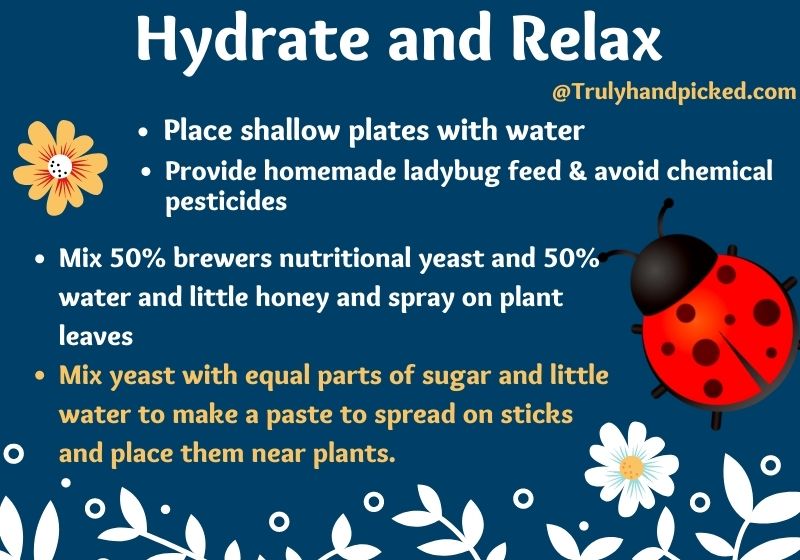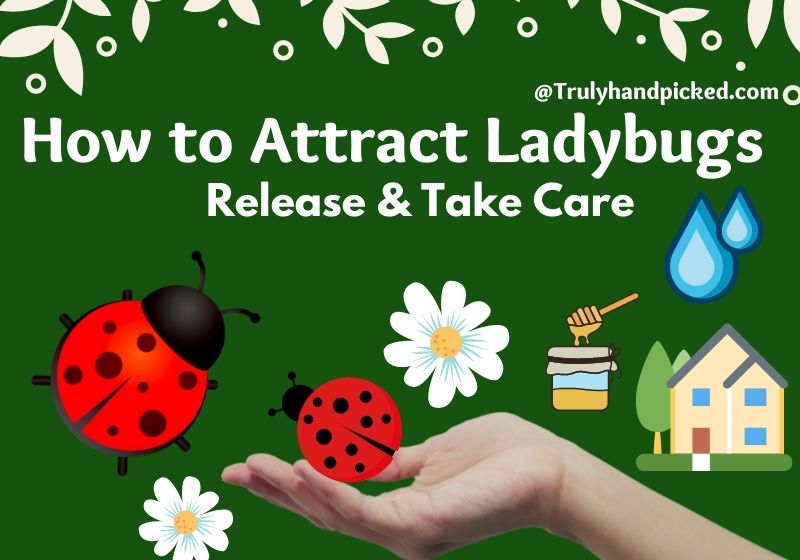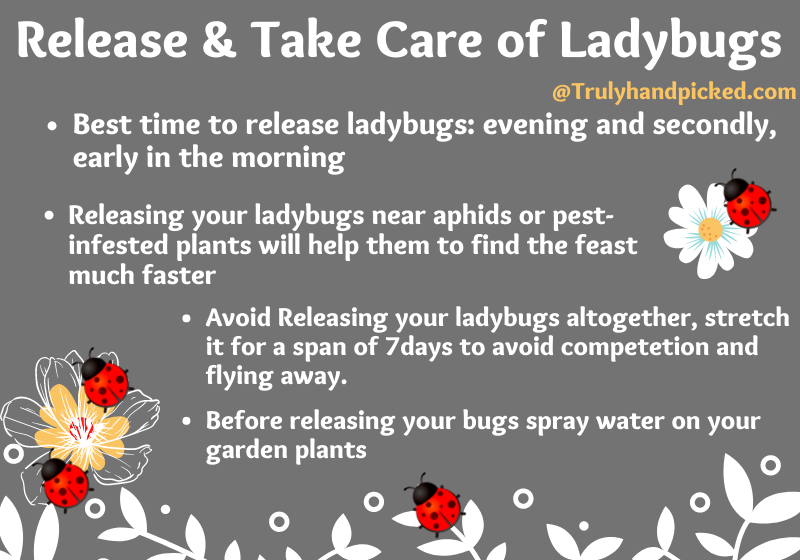Ladybugs or lady beetles (ladybirds UK ) are welcomed by every organic gardener to naturally get rid of insect pests.
In addition to controlling harmful pests, they are harmless and loved by kids for their graceful appearance. Fine, let’s jump into the quick overview and methods to attract and keep ladybugs in your garden.
Lady Beetles Quick Overview
- Ladybugs have bright colors, not just to attract kids 😛 but, to keep their predators away from munching them as a snack.
- These cute and pretty little bugs can hunt down most plant-damaging pests like mealybugs, aphids, mites, scales, whiteflies, and more.
- An adult beetle eats 1000s of crop-damaging pests and also lays eggs in the pest colonies. Later the larvae from these eggs feed on the pests and control the population of aphids and similar pests.
- Ladybugs are oscar level actors to play dead and secrete a foul-smelling fluid (yellow blood) to ooze out from their joints. This helps to repel birds, frogs, spiders, and similar predators.
- Ladybugs got their name from the virgin mary (our lady) with a virgin’s red cloak with spots of joys and sorrows. These beetles arrived after farmers prayed virgin mary for help to get rid of plant-eating pests. Thus beetles of our lady turned out to be cute ladybugs.
- Living up to 2years they can grow up to 0.4 inches
Related: How to attract birds to your garden
How to Attract Ladybugs to Your Garden
Just like any other living being, ladybugs are also attracted to a constant source of food, and water. And a protective comfy shelter to protect themself from climate and predators.
Once your garden is all set, it’s going to lure the pretty bugs to your garden. let’s check them out one by one.

Provide enough food source
Ladybugs are attracted to plant-damaging insect pests and pollen from flowering plants. Grow plants that attract the bugs to your garden. What? Yes, it may sound funny but, to keep them in your garden your need to provide a steady source of food.
Once you have earned its trust they lay hundreds of eggs and colonize to keep your garden aphids-free zone. Plant decoy plants that are a favorite for aphids and similar pests.
Related: How to attract earthworms to your garden
Best plants to attract ladybugs:
Grow plants like nasturtium which acts as a trap plant and attracts aphids and squash bugs from other plants. Secondly, nasturtium plants will attract other pollinators which can also munch on these pests.
Similarly grow mustard, marigold, radish, and cabbage to attract and trap the pests from jumping to your valuable plants. Meanwhile, this will charm the lady beetles into your garden and do the rest.
Grow fragrant and colorful flowering plants & herbs: Ladybugs also love flat flowers and bright yellow or white colors. As flat flowers help them as landing pads to land walk and eat from that flower. Plant flowers and herbs like dill, coriander, marigold, sunflower, zinnia, fennel, chives, calendula, and cosmos are shallow and flat flowers to attract ladybugs.
Apart from consuming nectar and eating pollen that doesn’t damage your plant leaves and flowers.

Water and Homemade Ladybug Feed
Place shallow plates with water: Next to food ladybugs need to hydrate themself to keep themselves going on. Though these beetles can drink water from the surface of leaves and flowers, placing shallow dishes with water.
This is an added advantage that brings hope to the ladybugs to stay in your garden. Also, place some rocks or pebbles in the dish that could help these little friends land and sip some water.
Homemade Ladybug Feed: Mix 50%brewers nutritional yeast and 50% water and little honey and spray on plant leaves. Worry not this is not going to hurt your plant, and this is going to be an alternative food source for your little beetles.
Related: How to attract bees to your garden.
Also, you mix yeast with equal parts of sugar and little water to make a paste. Later spread the paste on sticks and place these sticks around your plants as additional ladybug feed.
Avoid chemicals in your garden: Better if you shun the chemical fertilizers, herbicides, and pesticides used in your garden. As chemicals are not selective, it’s going to harm all types of beetles, bugs, and insects and eventually discourage the ladybugs.

How and When to Release Ladybugs
If you find it hard to attract ladybugs to your garden, you can buy live ladybugs from local garden stores or order online.
Keeping them in the refrigerator (not in the freezer) makes the bugs alive in a dormant state like hibernation in winter. This may help to reduce the mortality rate, until the perfect release time.
Though they can survive there for weeks together in your refrigerator, you should decide faster on where and when to release your beetles.
Before releasing your bugs spray water on your garden plants which helps to hydrate the thirsty beetles after the first break.
Best time to release ladybugs from flying away: Ladybugs need light and a little warmer of the day to fly away. So, it’s better to release these bugs by the evening and secondly, early in the morning. This way instead of flying immediately they spend time crawling and search food to stay.
That’s why it is recommended to keep your garden hydrated along with food spots to hang around before the release. Above all releasing your ladybugs near aphids or pest-infested plants will help them to find the feast much faster.
Releasing your ladybugs altogether: If you have a small garden and limited food source, avoid releasing all of them at once. Releasing them all at once or in one place will make them fly away to avoid competition. You choose to release them over a span of 7 days.

How to Take Care of Ladybugs and Create a Habitat
Create bugs tend to cover themself up for winter in tree cracks and piles of wood barks and dry leaves. So, have some ground cover plant spots in your garden to provide a hideout from its predators.
Also, do mulching, and add leaf litter around your garden plants to give some narrow openings and hiding spots.
Hanging restaurants and hideouts: Hang hollow pipes or logs or cut bamboo with an opening on two sides. Also, place some soaked soft raisins to attract and provide shelter for these little predators.
This will help these cute beetles to feel safe, stay, reproduce, lay eggs and hibernate.
How to Create an indoor habitat for ladybugs
Once you catch a few ladybugs place them in a container with small holes for ventilation, or use a glass jar with cheesecloth or mesh to cover.
If you want to keep it for a few days and observe, place some twigs, sticks, and leaves so that it can feel at home.
Food and water: Add a few torn pieces of lettuce, and soaked and soft raisins. Along with this place a small bottle cap with water and drops of honey. Also, you place a wet sponge or damp tissue or towel to keep these little ones hydrated.
Make sure the container doesn’t turn wet and has standing water, as it can harm the ladybugs.
Once you have enough playing and had fun with these beetles release them outdoors. So, that they can truly return to back their home. Also plan to release it long before winter so that they find a place to settle and hibernate before the temperature drops down.
Ladybugs Quick Look
Do ladybugs harm humans: No they are cute little predators that hunt on aphids and are totally harmless to humans. In rare cases it may bite, it will be rather felt as pinching, and does carry parasites.
Ladybugs act dead: If rough-handled by kids or threatened by predators they act dead and do reflex bleeding. Leaking from joints its blood can smell bad and stain your fabric and walls. But, the ladybugs do pay a price for this reflex bleeding, yes a compromised weakened immune system and delayed reproduction.
Ladybugs invasion in my home: Don’t worry they are not going to eat wood or fabric and are totally harmless. They are just seeking protection from the freezing climate outdoors to hibernate and stay warm in the nooks and crannies of your home. One bad thing is they can stain your carpet, walls, and curtains with their reflex bleeding.
Keeping ladybugs as pets: Yes, it’s bright, colorful, and graceful to have as a cute pet that doesn’t require much room. Until you have enough time to take care to provide their basic needs such as food and water, you can.
Though you can mimic nature’s habitat in a container, ladybugs are better returned to their true home outdoors. Unless it’s freezing winter and you can provide and better life.
What to feed these beetles: Feed them water mixed with honey drops, moist raisins, banana pieces, and pieces of lettuce. Only sweet fruits which are not acidic in nature. Though they eat fruits and sip honey water, their favorite from nature is nectar, aphids, and similar plant-threatening soft-bodied insects.
Ladybugs’ lifespan: They can happily roam around and eat plant pests and live happily for 1-2 years. And the same goes for ladybugs in captivity indoors, which can live for 1-2years with proper food and hydration, and care.
Poisonous ladybugs: They are not poisonous to humans. Yet for a few birds and lizards, they are toxic and their bright colors warn the predators not to have them as a snack. Also, rare cases have shown it can show some side effects if your dog has eaten a ladybug.
Ladybug has two wings: Yes it is two sets of wings. Yes, the outer pair of wings are actually modified forewings called elytra which is meant for its protective purpose. It’s a shell that protects the hind wings from water and covers its soft body. When the ladybugs don’t fly, they tuck their wings inside adjusting their abdomen and outer shell.